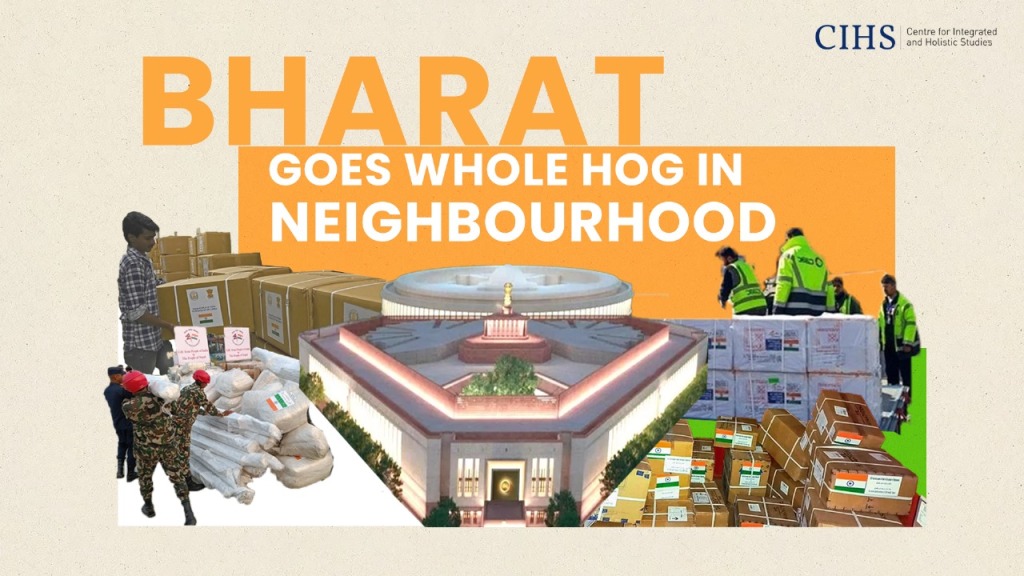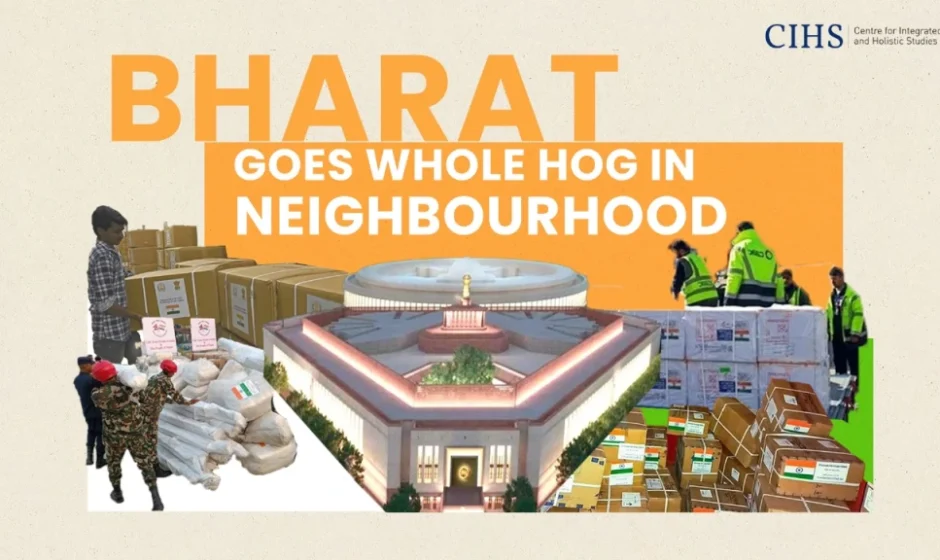Stability, progress and growth is what Bharat seeks to achieve in South Asia through its ‘neighbourhood first’ policy
Dr Divya Gupta
Post-independence in 1947, Bharat pursued a regional policy based on the principle that neighbours are important to national security and a market that can contribute to India’s economic development.

Given the bipolar world order that prevailed during Cold War, Bharat pursued non-alignment based on its stated global role as the third-world leader. India built her policy on the basis of “The Five Principles of Peaceful Co-existence” (Panchsheel) which was first signed on April 28, 1954 between then Prime Minister Jawaharlal Nehru and his Chinese counterpart Zhou Enlai. Panchsheel covered issues like sovereignty and integrity, territorial integrity, no mutual aggression, non-interference in each other’s internal affairs, equality, mutual benefit and peaceful coexistence.
Panchsheel agreement was considered one of the significant bases for building foreign policy with immediate neighbouring countries that India pursued after independence.
But, Prime Minister Nehru was particularly interested in building and strengthening international cooperation especially among developing countries. Indian foreign policy during that period had focused more on international relations than neighbourhood relations.
After end of Cold War, India made significant adjustments in her foreign policy framework owing to international, regional changes and internal challenges. Over the years, India has gradually come to occupy a significant role on strategic chessboard within the region and the world.
A person who thought ahead about close relationship with neighbouring countries was former Prime Minister Inder Kumar Gujral, known for his Gujral doctrine, a policy orienting the relationship between India and its neighbours.
Gujral doctrine was a policy that sought friendship based on sovereign equality and non-interference with “non-reciprocal magnanimity” towards smaller countries such as Bangladesh, Nepal, and Sri Lanka. The incumbent Prime Minister Narender Modi has formulated, followed and executed “neighbourhood first policy” in letter and spirit with respect to our immediate neighbours including Afghanistan.
Essence of this policy is the desire to effectively contribute to the construction and architecture to establish a stable foundation of peace and cooperation in South Asia in particular and Asia in general as a responsible, stable and large country.
Narendra Modi expanded the matrix of his foreign policy framework, took new line showing distinct imprint in his policies. He formulated his foreign policy doctrine (Modi doctrine) and introduced new pillars of India’s foreign policy (Panchamrit) including five pillars: dignity, dialogue, shared prosperity, regional and global security, cultural and civilization linkages aimed at affirming India’s position as a rising power in the world.
During high-level discussion at 69th session of United Nations General Assembly in September 2014, Prime Minister Modi said, “The destiny of a country is linked to its neighbourhood. That is why my government has placed the highest priority on advancing friendship and cooperation with neighbours” (Modi 2014). He argued that “neighbours are the number one priority” which is considered a bright spot in India’s foreign policy.
India’s ‘Neighbourhood First policy’ guides its approach towards management of relations with countries in its immediate neighbourhood, i.e. Afghanistan, Bangladesh, Bhutan, Maldives, Myanmar, Nepal, Pakistan and Sri Lanka. The policy is based on the idea that a stable and prosperous neighbourhood is essential for Bharat’s economic and security interests. The Neighbourhood First Policy is also part of Bharat’s larger vision of becoming a leading power in the region and world.
India’s Neighbourhood First policy can also be seen as a manifestation of Modi government’s vision of building ‘Vasudhaiva Kutumbakam (the world as one family). Vaccine diplomacy and development assistance based on mutual respect and equal partnership are two most important pillars to catapult India’s Neighbourhood First policy[i].
Vaccine diplomacy has been seen as pragmatic response to a global pandemic and way to strengthen its image as a responsible leader at both regional and global levels. Noteworthy, Indian diplomacy, particularly during the Covid-19[ii] pandemic, resulted in India being recognised on the world stage as a harbinger of hope providing necessary help to needy nations and their people globally.
As part of India’s Neighbourhood First policy, India, through its vaccine diplomacy (Vaccine Maitri)[iii], extended help to many countries of the world and neighbouring countries during the Covid-19 pandemic. Also, and notwithstanding that India was affected very badly, particularly during the second wave, India handled the situation very well to overcome the worst effects of the pandemic relatively, and at the same time, help other countries to address the challenge.
Primary beneficiaries of Vaccine Maitri in South Asian region are Bangladesh (Rs 22.5928 million in total supplies in the form of commercial and grant assistance, followed by Nepal (Rs 9.499 million); Sri Lanka (Rs 1.2640 million); Afghanistan (Rs 1.4680 million); Bhutan (Rs 0.55 million) and Maldives (Rs 0.312 million). India committed $10 million to South Asian Association for Regional Cooperation (SAARC) Fund to address the global pandemic.
Keeping with the spirit of Vasudhaiva Kutumbakam, India is providing support to Afghanistan and Sri Lanka to address their myriad challenges through its development assistance initiative. Since the Taliban assumed charge in Afghanistan, India supplied wheat and other essential food items and Covid-19 vaccines as humanitarian aid to Afghanistan. In its budget for 2022-23, India allocated Rs 2,000 million as development assistance to Afghanistan.
Apart from this India also provides financial assistance to neighbouring countries through Lines of Credit (LoCs), Grant-in-aid, Credit Facility, Currency Swap Facility and others. India has extended four Lines of Credit worth US $ 7.862 billion to Bangladesh under Indian Development and Economic Assistance Scheme (IDEAS). India also supports Bangladesh in several developmental and infrastructure projects across sectors such as roads, highways, railways, ports, power transmission, waste management, economic zones, information and communication technology, solar power generation etc.
India has also provided Rs. 45,000 million as development assistance for 12th Five Year Plan (November 2018-October 2023) to Bhutan. India has extended five LoCs totalling to US $ 1.33 billion[iv] to Maldives including assistance to Greater Male Connectivity Project. India has provided budgetary support to Maldives. In September 2020, India offered US $ 250 million in financial assistance to Maldives to mitigate the impact of Covid 19 on the Maldivian economy.
India extended 10 LoCs worth US $ 475.57 million to Myanmar for infrastructure projects across sectors including railways, power, telecommunication, oil refineries, irrigation & agriculture. India’s development assistance to Myanmar is over US $ 2 billion with majority of the infrastructure projects being implemented under grant-in-aid. India has been providing development assistance to Nepal, including in development of infrastructure along Indo-Nepal border viz. Integrated Check Posts (ICPs), Rail Links[v], roads, school buildings, health facilities including through HICDPs, gifting ambulances and buses, post-earthquake reconstruction in housing, education, health and cultural heritage sector, etc.
Four LoCs have been extended to Nepal aggregating US $ 1.65 billion for various infrastructure development projects. Sri Lanka is one of the major recipients of India’s development assistance. India’s overall commitment to Sri Lanka[vi] is more than US $ 5 billion, of which around US $ 600 million is grant-in-aid and the rest made available as concessional loan.
In total, 13 Lines of Credit worth US $ 2.68 billion have been extended to Sri Lanka. India continues to assist Sri Lanka in its economic development as also support it in overcoming its economic challenges. In January 2022, India extended a US $ 400 million currency swap to Sri Lanka under the SAARC Framework and deferred successive Asian Clearing Union (ACU) settlements till July 6, 2022. A Line of Credit of US $ 500[vii] million was extended to Sri Lanka for importing fuel from India.
In addition, India extended a credit facility of US $ 1 billion for procurement of food, medicines and other essential items from India. Humanitarian assistance was also provided to Sri Lanka by gifting essential medicines worth about Rs 60 million, 15,000 litres of kerosene oil and US $ 55 million LoC to procure Urea. Tamil Nadu state has contributed rice, milk powder and medicines worth US $ 16 million as part of larger Indian assistance effort.
Under Prime Minister Modi’s leadership, India is actively pursuing a “neighbourhood first policy” to foster more meaningful and deeper engagement with neighbouring countries. This endeavour seeks to restore India’s prestige, image and influence in the region.
There are more reasons to push for Neighbourhood First policy in the future: First, sustained engagement with neighbouring countries will facilitate creating a cordial atmosphere in the region which has been a constant impediment to establishing stability, trust and progress in the area. Stability will enable India to pursue its foreign policy goals and facilitate growth and development in other South Asian countries.
Second, by extending necessary assistance, India can strengthen its position in the region and achieve both economic and strategic depth vis-à-vis China. The foreign policy has been woven around wisdom of late Prime Minister Atal Bihari Vajpayee who had famously said that “we can change friends but not neighbours”.
(Author is an Assistant Professor Dept. of Law, Himachal Pradesh University Regional Centre Dharamshala)
[i] https://kathmandupost.com/columns/2022/05/15/india-s-neighbourhood-first-policy
[ii] https://www.thestatesman.com/opinion/seeking-primacy-neighbourhood-1503073530.html
[iii] https://kathmandupost.com/columns/2022/05/15/india-s-neighbourhood-first-policy
[iv] https://sansad.in/getFile/annex/257/AU1342.pdf?source=pqars
[v] https://www.mea.gov.in/rajya-sabha.htm?dtl/35554/QUESTION+NO1342+BILATERAL+RELATIONS+WITH+NEIGHBOUR-
[vi] https://www.mea.gov.in/rajya-sabha.htm?dtl/35609/QUESTION_NO2135_INDIAS_STAND_ON_SRI_LANKAN_CRISIS
[vii] https://www.mea.gov.in/rajya-sabha.htm?dtl/36160/question+no67+diplomatic+relationship+between+india+and+sri+lanka

